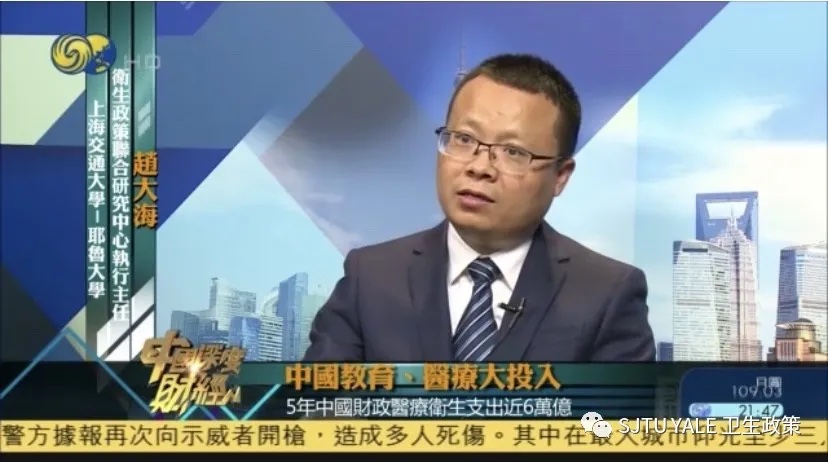上海交大赵大海做客凤凰卫视:中国医疗卫生事业在“十四五”期间将有巨大发展

上海交通大学国际与公共事务学院教授、博士生导师,上海交通大学-耶鲁大学卫生政策联合研究中心执行主任赵大海于2021年3月13日做客香港凤凰卫视,在《中国深度财经》节目,就“两会”有关习近平总书记看望出席政协会议的医疗卫生教育界委员时强调的“要把保障人民健康放在优先发展的位置”以及李克强总理在会见中外记者时提到“国家财政将向基本医疗进一步倾斜”等话题进行了访谈,现将有关访谈内容摘录如下。
中国国务院关于财政医疗卫生资金分配和使用情况的一份报告显示,2013年到2017年,中国财政医疗卫生累计支出59502亿元,年均增幅为11.7%。报告指出,通过加大供需双方投入力度,促进基本医疗卫生服务均等化,引导财政资金和资源下沉,支持疾病预防和健康促进工作投入成效不断显现,中国健康水平稳步提升。
赵大海:整个的“十三五”期间,因为今年是“十四五”的开局之年,就整个的“十三五”期间,过去的五年,我们政府对医疗卫生的财政投入还是按照“十二五”期间基本上一致的增幅在进行比较稳健的财政投入。截止最新的统计数据,2019年底的数据显示:2019年各级政府对医疗卫生的财政投入是1.8万亿元左右。这个数据占我们当年整个财政支出的比例是7.5%,应该讲政府对医疗卫生的财政投入在过去的几年满足了基本的医疗卫生服务包括公共卫生服务的需要。
报告指出,当前中国医疗卫生资金投入使用呈现出了机制逐步健全、总量持续增加、结构日趋优化、效益不断提高的良好态势,但也面临了一些问题和挑战。一是改革措施仍需加强,二是可持续性的压力加大,三是费用结构,四是绩效管理亟待加强。中国工程院院士曾表示,2019年,中国中央政府和地方政府在医疗卫生领域的财政支出占总支出的比例为刚刚超过7%,2020年,这一数据为7.2%,而国际上该数据的平均水平是14-20%,相当多的国家占20%以上。另外,中国医疗卫生费用占GDP大约是5%-6%,远低于世界平均水平,该数据的世界平均水平为7%。中国在医疗卫生上的投入还有巨大的提升空间。
赵大海:当然了,随着全国居民的需求不断的提高,我们还得进一步地通过改革医疗服务的支付体系,特别是医疗保障体系,包括改革各类医疗机构的运行体系,让更多的老百姓,能够真正地实现看得上病、看得起病。
供稿者:国务学院
日期:2021年3月15日
Dahai ZHAO’s Exclusive Interview with PhoenixTV: China is bound to make notable progress in health undertakings during its 14th Five-Year Plan period (2021-2025)
Dahai Zhao, a doctoral supervisor at the School of International and Public Affairs of Shanghai Jiao Tong University and Executive Director of Shanghai Jiao Tong University-Yale University Joint Research Center for Health Policy, has been interviewed by phoenixTV. On March 13, 2021, Zhao commented on General Secretary Xi Jinping’s "the protection of people's health should be given priority to development" when he visited the health and education committee on the CPPCC session, and Premier Li Keqiang’s "the national finance will be further tilted toward basic medical care" when he met with Chinese and foreign journalists on China Finance and Economics.
From 2013 to 2017, China's fiscal expenditure on medical and health care totaled 5.9502 billion yuan, with an average annual growth rate of 11.7 percent, according to a report by the State Council on the allocation and use of medical and health funds. According to the report, China's health has been steadily improved by increasing input from both supply and demand, promoting equal access to basic medical and health services, guiding the sinking of financial funds and resources, and making continuous progress in supporting disease prevention and health promotion.
ZHAO: This year is the beginning of the 14th Five-Year Plan period. During the 13th Five-Year Plan period, the government's fiscal input in medical and health care has maintained a relatively steady growth rate in accordance with the basically the same growth rate during the 12th Five-Year Plan period. As of the latest statistics, governments at all levels have invested about 1.8 trillion yuan in medical and health care in 2019. This figure accounted for 7.5% of our total fiscal expenditure in that year. It should be said that the government's financial investment in health care has met the needs of basic medical and health services, including public health services, in the past few years. The report pointed out that China's current medical and health fund investment shows a good trend, like increasing the total amount, optimizing the structure and improving the benefits, when facing some problems and challenges as well. First, the reform measures still need to be strengthened; second, the pressure on sustainability is increasing; third, the cost structure; fourth, the performance management needs to be strengthened. An academician from the Chinese Academy of Engineering said that the central and local government's fiscal spending on health care accounted for just over 7 percent of China's total spending in 2019. In 2020, the figure is 7.2 percent. The international average is 14-20%, with a considerable number of countries accounting for more than 20%. In addition, China's health spending accounts for about 5%-6% of GDP, much lower than the world average of 7%. There is still much space for improvement in China's spending on health undertakings.
ZHAO: Of course, as the needs continue to rise, we'll have to go further by reforming the payment system. In particular, the medical security system, including the reform of the operating system and improving the access to hospital care for all Chinese.
Contributor: SIPA, SJTU
Date: March 15, 2021

